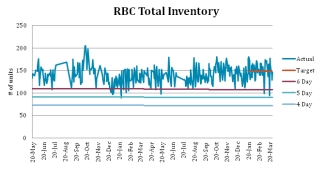Understanding Hospital Inventory
In 2013, the National Advisory Committee on Blood and Blood Products made recommendations for monitoring red blood cell inventory in hospitals using an “inventory index” with suggested minimum necessary data elements during an inventory shortage.
These data elements include calculating an average daily red cell demand (ADRD) using red blood cell disposition data (transfused+outdated+wasted) dividing by a specific time period (90 or 365 days) and further using the ADRD to determine an inventory index from actual inventory levels (inventory index = actual inventory/ADRD).
Although recommended for use during an inventory shortage situation, the Utilization Team at Canadian Blood Services recognized the value in developing a tool using these data elements to better engage with hospitals and understand hospital inventory levels during times of optimal inventory.

Work is underway to have regularly updated hospital-specific inventory trend reports available to all hospitals served by Canadian Blood Services. The reports will facilitate conversations with hospitals regarding red blood cell inventory requirements to better understand what a specific red blood cell inventory level means in consideration of actual red blood cell usage over time. These inventory trend reports are foundational to further evolve collaborative inventory initiatives between Canadian Blood Services and hospitals.
Your hospital liaison specialist will let your hospital transfusion service know when the hospital-specific inventory trend reports will be available to all hospitals.